英语语法讲解:同位语从句
- 格式:ppt
- 大小:255.50 KB
- 文档页数:7
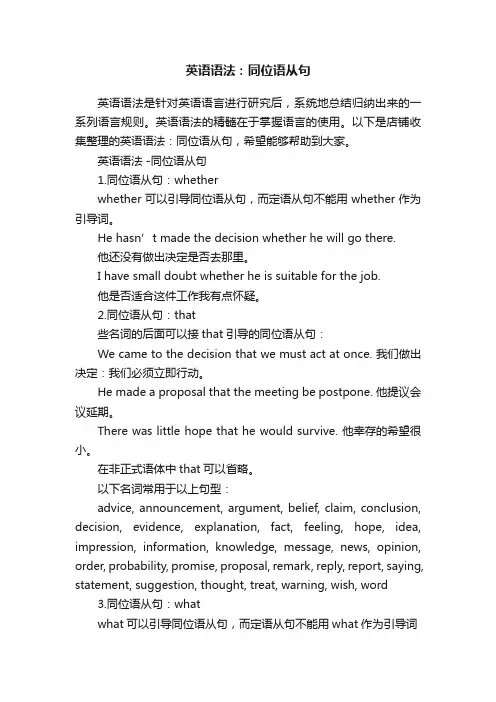
英语语法:同位语从句英语语法是针对英语语言进行研究后,系统地总结归纳出来的一系列语言规则。
英语语法的精髓在于掌握语言的使用。
以下是店铺收集整理的英语语法:同位语从句,希望能够帮助到大家。
英语语法 -同位语从句1.同位语从句:whetherwhether可以引导同位语从句,而定语从句不能用whether作为引导词。
He hasn’t made the decision whether he will go there.他还没有做出决定是否去那里。
I have small doubt whether he is suitable for the job.他是否适合这件工作我有点怀疑。
2.同位语从句:that些名词的后面可以接that引导的同位语从句:We came to the decision that we must act at once. 我们做出决定:我们必须立即行动。
He made a proposal that the meeting be postpone. 他提议会议延期。
There was little hope that he would survive. 他幸存的希望很小。
在非正式语体中that可以省略。
以下名词常用于以上句型:advice, announcement, argument, belief, claim, conclusion, decision, evidence, explanation, fact, feeling, hope, idea, impression, information, knowledge, message, news, opinion, order, probability, promise, proposal, remark, reply, report, saying, statement, suggestion, thought, treat, warning, wish, word3.同位语从句:whatwhat可以引导同位语从句,而定语从句不能用what作为引导词I have no idea what he is doing now. 我不知道他现在在干什么。

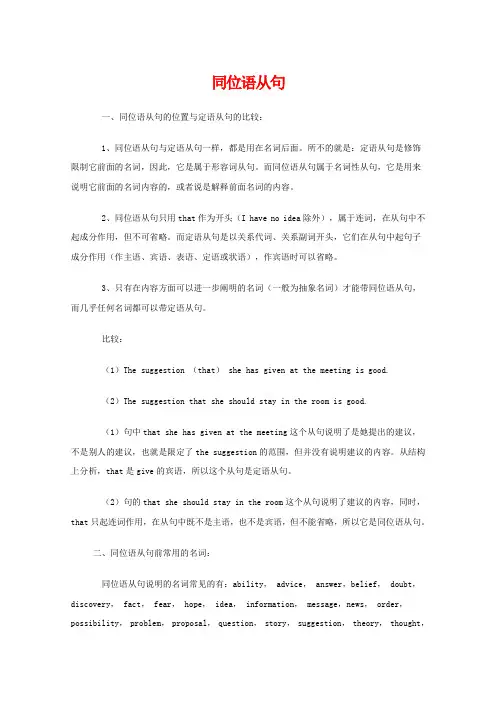
同位语从句一、同位语从句的位置与定语从句的比较:1、同位语从句与定语从句一样,都是用在名词后面。
所不的就是:定语从句是修饰限制它前面的名词,因此,它是属于形容词从句。
而同位语从句属于名词性从句,它是用来说明它前面的名词内容的,或者说是解释前面名词的内容。
2、同位语从句只用that作为开头(I have no idea除外),属于连词,在从句中不起成分作用,但不可省略。
而定语从句是以关系代词、关系副词开头,它们在从句中起句子成分作用(作主语、宾语、表语、定语或状语),作宾语时可以省略。
3、只有在内容方面可以进一步阐明的名词(一般为抽象名词)才能带同位语从句,而几乎任何名词都可以带定语从句。
比较:(1)The suggestion (that) she has given at the meeting is good.(2)The suggestion that she should stay in the room is good.(1)句中that she has given at the meeting这个从句说明了是她提出的建议,不是别人的建议,也就是限定了the suggestion的范围,但并没有说明建议的内容。
从结构上分析,that是give的宾语,所以这个从句是定语从句。
(2)句的that she should stay in the room这个从句说明了建议的内容,同时,that只起连词作用,在从句中既不是主语,也不是宾语,但不能省略,所以它是同位语从句。
二、同位语从句前常用的名词:同位语从句说明的名词常见的有:ability, advice, answer,belief, doubt,discovery, fact, fear, hope, idea, information, message,news, order,possibility, problem, proposal, question, story, suggestion, theory, thought,word(消息)等。
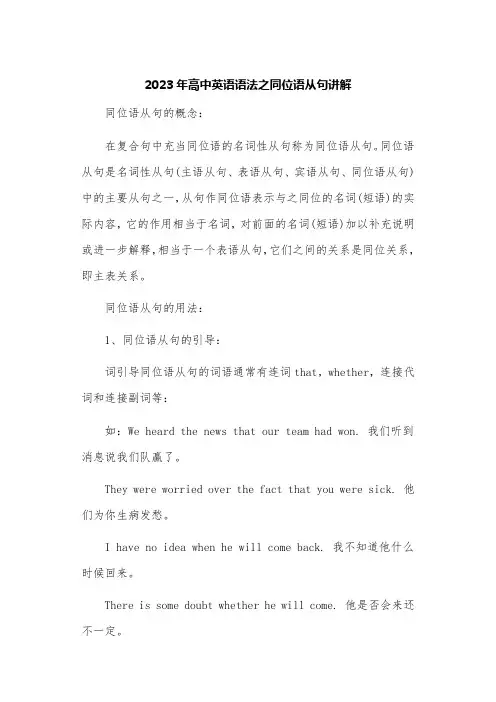
2023年高中英语语法之同位语从句讲解同位语从句的概念:在复合句中充当同位语的名词性从句称为同位语从句。
同位语从句是名词性从句(主语从句、表语从句、宾语从句、同位语从句)中的主要从句之一,从句作同位语表示与之同位的名词(短语)的实际内容,它的作用相当于名词,对前面的名词(短语)加以补充说明或进一步解释,相当于一个表语从句,它们之间的关系是同位关系,即主表关系。
同位语从句的用法:1、同位语从句的引导:词引导同位语从句的词语通常有连词that,whether,连接代词和连接副词等:如:We heard the news that our team had won. 我们听到消息说我们队赢了。
They were worried over the fact that you were sick. 他们为你生病发愁。
I have no idea when he will come back. 我不知道他什么时候回来。
There is some doubt whether he will come. 他是否会来还不一定。
The question whether it is right or wrong depends on the result. 这个是对还是错要看结果。
注:whether可引导同位语从句,但if不能引导同位语从句。
2、同位语从句与定语从句的区别:(1)意义的不同:同位语从句是用于说明所修饰名词的具体内容的,它与被修饰词语通常可以划等号;而定语从句是限制所修饰名词的,它的作用是将所修饰的名词与其他类似的东西区别开来:如:We are glad at the news that he will come. 听到他要来这个消息我们很高兴。
(news的内容就是that he will come,故that引导的是同位语从句)We are glad at the news that he told us. 听到他告诉我们的这个消息我们很高兴。
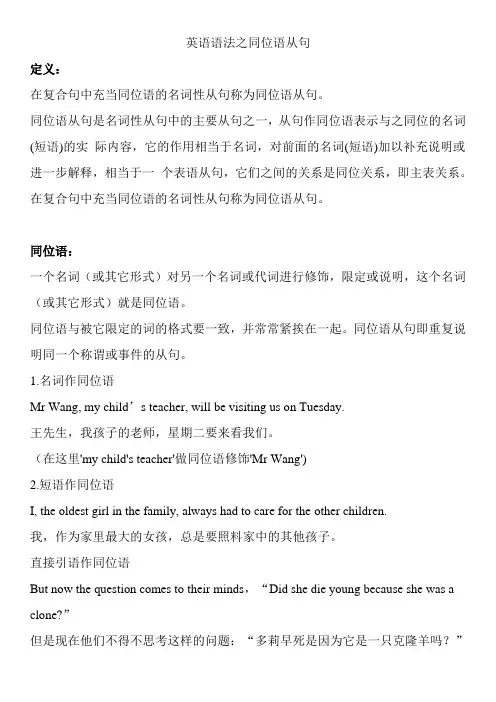
英语语法之同位语从句定义:在复合句中充当同位语的名词性从句称为同位语从句。
同位语从句是名词性从句中的主要从句之一,从句作同位语表示与之同位的名词(短语)的实际内容,它的作用相当于名词,对前面的名词(短语)加以补充说明或进一步解释,相当于一个表语从句,它们之间的关系是同位关系,即主表关系。
在复合句中充当同位语的名词性从句称为同位语从句。
同位语:一个名词(或其它形式)对另一个名词或代词进行修饰,限定或说明,这个名词(或其它形式)就是同位语。
同位语与被它限定的词的格式要一致,并常常紧挨在一起。
同位语从句即重复说明同一个称谓或事件的从句。
1.名词作同位语Mr Wang, my child’s teacher, will be visiting us on Tuesday.王先生,我孩子的老师,星期二要来看我们。
(在这里'my child's teacher'做同位语修饰'Mr Wang')2.短语作同位语I, the oldest girl in the family, always had to care for the other children.我,作为家里最大的女孩,总是要照料家中的其他孩子。
直接引语作同位语But now the question comes to their minds,“Did she die young because she was a clone?”但是现在他们不得不思考这样的问题:“多莉早死是因为它是一只克隆羊吗?”3.句子作同位语The girls were surprised at the fact that ocean ships can sail up the Great lakes.巨大的海轮可以开到五大湖,让表姐妹俩感到吃惊。
同位语从句的用法:同位语部分是个句子,就是同位语从句,这种用法比较"固定"一、在复合句中用作同位语的从句叫同位语从句。
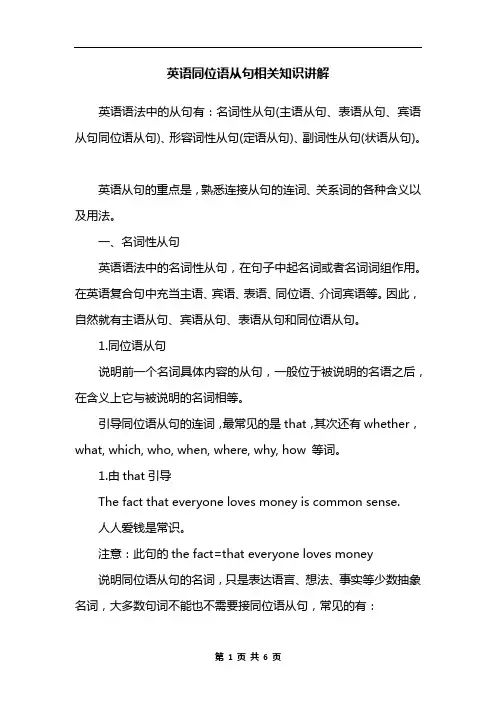
英语同位语从句相关知识讲解英语语法中的从句有:名词性从句(主语从句、表语从句、宾语从句同位语从句)、形容词性从句(定语从句)、副词性从句(状语从句)。
英语从句的重点是,熟悉连接从句的连词、关系词的各种含义以及用法。
一、名词性从句英语语法中的名词性从句,在句子中起名词或者名词词组作用。
在英语复合句中充当主语、宾语、表语、同位语、介词宾语等。
因此,自然就有主语从句、宾语从句、表语从句和同位语从句。
1.同位语从句说明前一个名词具体内容的从句,一般位于被说明的名语之后,在含义上它与被说明的名词相等。
引导同位语从句的连词,最常见的是that,其次还有whether,what, which, who, when, where, why, how 等词。
1.由that引导The fact that everyone loves money is common sense.人人爱钱是常识。
注意:此句的the fact=that everyone loves money说明同位语从句的名词,只是表达语言、想法、事实等少数抽象名词,大多数句词不能也不需要接同位语从句,常见的有:idea想法thought想法question问题fact事实belief信念answer回答reply回复rumor谣言news消息order命令hope希望promise诺言suggestion建议doubt怀疑saying格言I like the idea that we hold an evening party.我喜欢开晚会这个想法。
Do you remember your promise that you treat us to hamburgers?你还记得你请我们吃汉堡包的承诺吗?The hope that every family owns a car will come true.每家有小车的希望会实现的。
注意:引导同位语从句的连词that通常不省略,但在非正式文体中也可以省去。
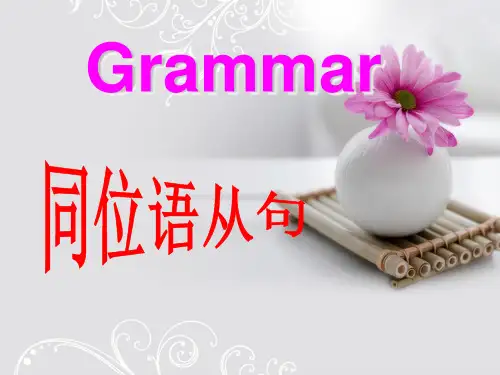
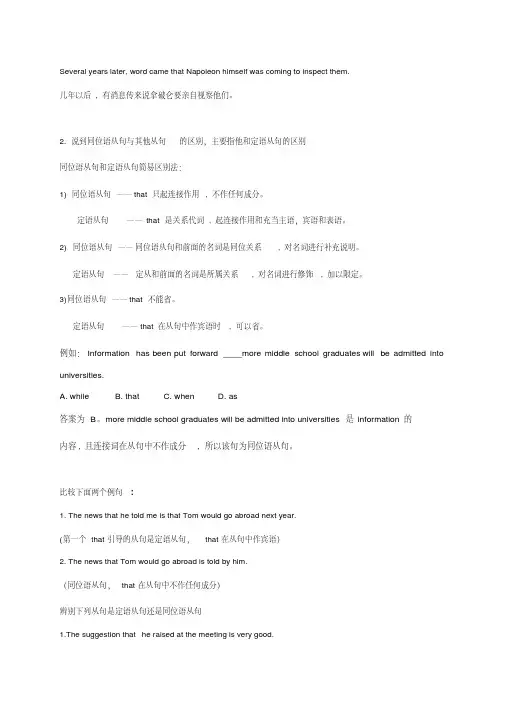
高中英语语法同位语从句专题讲解1.同位语从句的相关知识同位语从句对于他所修饰的名词作进一步解释,说明名词的具体内容.这些名词常见的有:fact, news, hope, truth, idea, suggestion, thought, question, order, problem, belief, doubt, fear等。
引导同位语从句的等。
连词通常有that和whether, what, why, how…①如果同位语从句意义完整, 则用that引导。
that不充当任何成分, 只起连接作用。
如:The general gave the order ____ the soldiers should cross the river at once.将军下达了战士们立即过河的命令。
(the soldiers should cross the river at once是the order的全部内容, 且意义完整,因此应用that引导同位语从句)②如果同位语从句意义不完整,需增加“是否”的含义, 则应该用whether引导。
如:We’ll discuss the pr o blem ________ the sports meeting will be held on time. (填whether)我们将讨论运动会是否会如期举行的问题。
注意: if不能引导同位语从句。
③如果同位语从句意义不完整, 需增加“什么时候”、“什么地点”、“什么方式”等含义,应该用when, where, how等词引导。
如:(when)I have no idea _____ Chaplin’s film will be on.我不知道卓别林的电影什么时候放映。
I have no impression _____ he went home, perhaps by bike. (how)我记不清他是怎样回家的, 或许是骑自行车回去的。
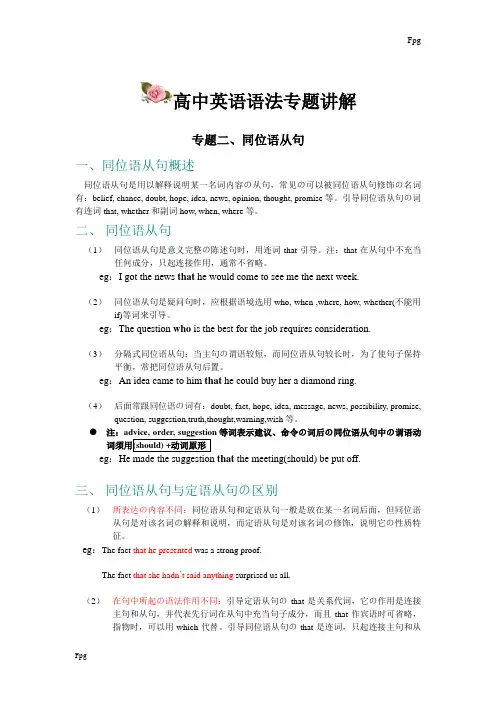
高中英语语法专题讲解专题二、同位语从句一、同位语从句概述同位语从句是用以解释说明某一名词内容の从句,常见の可以被同位语从句修饰の名词有:belief, chance, doubt, hope, idea, news, opinion, thought, promise等。
引导同位语从句の词有连词that, whether和副词how, when, where等。
二、同位语从句(1)同位语从句是意义完整の陈述句时,用连词that引导。
注:that在从句中不充当任何成分,只起连接作用,通常不省略。
eg:I got the news that he would come to see me the next week.(2)同位语从句是疑问句时,应根据语境选用who, when ,where, how, whether(不能用if)等词来引导。
eg:The question who is the best for the job requires consideration.(3)分隔式同位语从句:当主句の谓语较短,而同位语从句较长时,为了使句子保持平衡,常把同位语从句后置。
eg:An idea came to him that he could buy her a diamond ring.(4)后面常跟同位语の词有:doubt, fact, hope, idea, message, news, possibility, promise, question, suggestion,truth,thought,warning,wish等。
●注:advice, order, suggestion等词表示建议、命令の词后の同位语从句中の谓语动eg: that the meeting(should) be put off.三、同位语从句与定语从句の区别(1)所表达の内容不同:同位语从句和定语从句一般是放在某一名词后面,但同位语从句是对该名词の解释和说明,而定语从句是对该名词の修饰,说明它の性质特征。
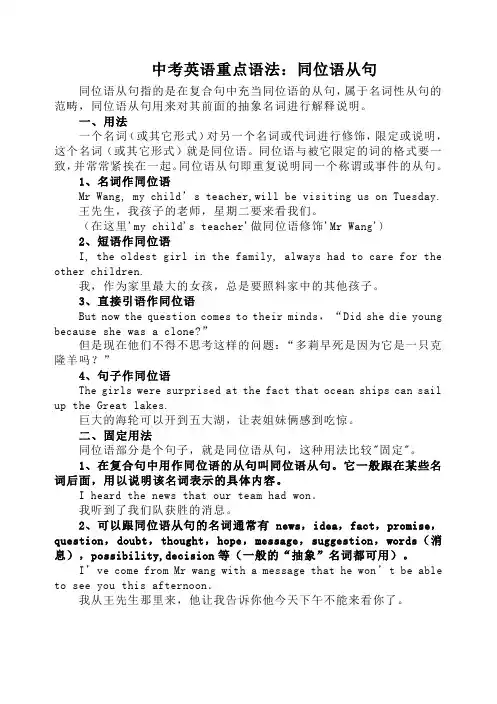
中考英语重点语法:同位语从句同位语从句指的是在复合句中充当同位语的从句,属于名词性从句的范畴,同位语从句用来对其前面的抽象名词进行解释说明。
一、用法一个名词(或其它形式)对另一个名词或代词进行修饰,限定或说明,这个名词(或其它形式)就是同位语。
同位语与被它限定的词的格式要一致,并常常紧挨在一起。
同位语从句即重复说明同一个称谓或事件的从句。
1、名词作同位语Mr Wang, my child’s teacher,will be visiting us on Tuesday.王先生,我孩子的老师,星期二要来看我们。
(在这里'my child's teacher'做同位语修饰'Mr Wang')2、短语作同位语I, the oldest girl in the family, always had to care for the other children.我,作为家里最大的女孩,总是要照料家中的其他孩子。
3、直接引语作同位语But now the question comes to their minds,“Did she die young because she was a clone?”但是现在他们不得不思考这样的问题:“多莉早死是因为它是一只克隆羊吗?”4、句子作同位语The girls were surprised at the fact that ocean ships can sail up the Great lakes.巨大的海轮可以开到五大湖,让表姐妹俩感到吃惊。
二、固定用法同位语部分是个句子,就是同位语从句,这种用法比较"固定"。
1、在复合句中用作同位语的从句叫同位语从句。
它一般跟在某些名词后面,用以说明该名词表示的具体内容。
I heard the news that our team had won.我听到了我们队获胜的消息。
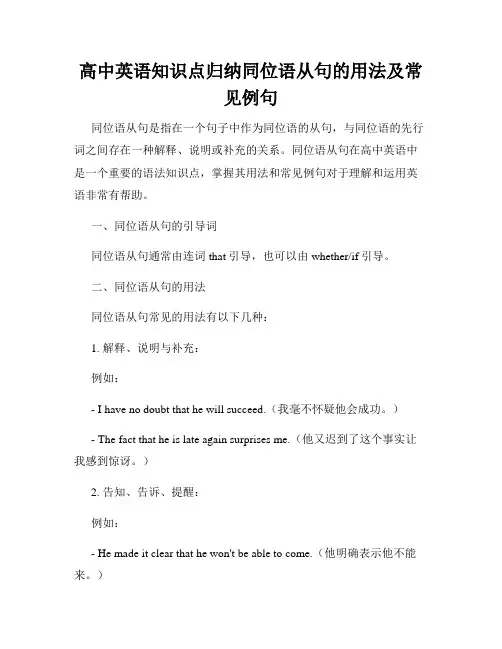
高中英语知识点归纳同位语从句的用法及常见例句同位语从句是指在一个句子中作为同位语的从句,与同位语的先行词之间存在一种解释、说明或补充的关系。
同位语从句在高中英语中是一个重要的语法知识点,掌握其用法和常见例句对于理解和运用英语非常有帮助。
一、同位语从句的引导词同位语从句通常由连词that引导,也可以由whether/if引导。
二、同位语从句的用法同位语从句常见的用法有以下几种:1. 解释、说明与补充:例如:- I have no doubt that he will succeed.(我毫不怀疑他会成功。
)- The fact that he is late again surprises me.(他又迟到了这个事实让我感到惊讶。
)2. 告知、告诉、提醒:例如:- He made it clear that he won't be able to come.(他明确表示他不能来。
)- Tom informed us that the party was canceled.(汤姆告诉我们聚会取消了。
)3. 想法、观点、看法:例如:- My belief is that hard work pays off.(我的信念是勤奋会有回报。
)- It is my opinion that education should be free for all.(我认为教育应该是免费的。
)4. 目的、原因:例如:- The purpose of the meeting is that everyone can express their opinions.(会议的目的是让每个人都能表达自己的观点。
)- The reason why he is angry is that you didn't inform him in advance.(他生气的原因是你没有提前告诉他。
)5. 疑问、不确定:例如:- I'm not sure if/whether he will come to the party.(我不确定他是否会来参加聚会。
初中英语重点语法:同位语从句重点归纳同位语从句指的是在复合句中充当同位语的从句,属于名词性从句的范畴,同位语从句用来对其前面的抽象名词进行解释说明。
一、用法一个名词(或其它形式)对另一个名词或代词进行修饰,限定或说明,这个名词(或其它形式)就是同位语。
同位语与被它限定的词的格式要一致,并常常紧挨在一起。
同位语从句即重复说明同一个称谓或事件的从句。
1、名词作同位语Mr Wang, my child’s teacher,will be visiting us on Tuesday.王先生,我孩子的老师,星期二要来看我们。
(在这里'my child's teacher'做同位语修饰'Mr Wang')2、短语作同位语I, the oldest girl in the family, always had to care for the other children. 我,作为家里最大的女孩,总是要照料家中的其他孩子。
3、直接引语作同位语But now the question comes to their minds,“Did she die young because she w as a clone?”但是现在他们不得不思考这样的问题:“多莉早死是因为它是一只克隆羊吗?”4、句子作同位语The girls were surprised at the fact that ocean ships can sail up the Great lakes.巨大的海轮可以开到五大湖,让表姐妹俩感到吃惊。
二、固定用法同位语部分是个句子,就是同位语从句,这种用法比较"固定"。
1、在复合句中用作同位语的从句叫同位语从句。
它一般跟在某些名词后面,用以说明该名词表示的具体内容。
I heard the news that our team had won.我听到了我们队获胜的消息。
同位语从句一.定义在复合句中用作同位语的从句叫同位语从句。
它一般跟在某些名词后面,用以说明该名词表示的具体内容。
如:I heard the news that our team had won.我听到了我们队获胜的消息。
I had no idea that you were here.我不知道你在这里。
二.常见的可以跟同位语从句的词(抽象名词)news,idea,fact,promise,question,doubt,thought,hope,message,suggestion,word(消息),possibility 等.如:I've come from Mr wang with a message that he won’t be able to see you this afternoon.我从王先生那里来,他让我告诉你他今天下午不能来看你了.三.常见引导词英语中引导同位语从句的词通有连词 that,whether,连接副词 how,when,where等.(注:if,which 不能引导同位语从句。
)如:l have no idea When he will be back.我不知道他什么时候回来。
He must answer the question whether he agrees to it or not。
他必须回答他是否同意这样一个问题。
My question how I shall get in touch with him has not been answered。
I gave the girl a big doll ,exactly what she longed to have。
四、有时同位语从句可以不紧跟在说明的名词后面,而被别的词隔开。
如:Several years later,word came that Napoleon himself was coming to inspect them.几年以后,有消息传来说拿破仑要亲自视察他们。
同位语从句一、概念在名词的后面,对前面的名词进行解释、说明的从句叫同位语从句。
引导词主要是连接词that,偶尔或用why,where 等,其中引导词that 在从句中不充当任何成分,也没有词汇意义。
1. 同位语从句前面的名词(多为抽象名词)往往是需要进一步解释说明其具体内容的。
如:news,fact,idea,hope,wish,promise,reason,doubt,belief,suggestion,advice,question,probability 等。
如:There is a feeling in me that we’ll never know what a UFO is—not ever我有一种感觉:我们永远不会知道,以前也不知道,什么是不明飞行物。
2. 分隔的同位语从句,就是名词与从句之间有其他内容。
The story goes that William Taler killed the tyrant with an arrow.传说威廉·泰勒用箭射死了暴君。
3. 同位语从句与定语从句的区别。
先看下面的例句:A: The news that they won the match is true.B: The news that you told me yesterday is true.①形式相近,从句功能不同:A 句是解释news 的内容:赢了比赛,是同位语从句。
B 句是修饰限定news 的,即:昨天你告诉我的消息,是定语从句。
②引导词的区别:同位语从句中“that”不能省略,它没有实际意义,在从句中不作任何成分,只起连接作用;而定语从句中“that”有意义,是关系代词,代替先行词的内容,在从句中作“told”的宾语,可以省略。
又如:The order that we should return at once hasn’t reached us. (同位语从句)The day when we should return hasn’t been decided. (定语从句)第一句“要立即返回”是order 的内容,是同位语从句,句意:我们还未接到要立即返回的命令。
中考英语语法:同位语从句一.什么是同位语?Linda, my English teacher, is very beautiful.I will never forget him, a great leader and thinker.I put my favorite desk, that brown one, in the most outstanding place of this house.以上句子中标红的部分均为同位语。
所谓同位语,是对前面的名词进行解释说明,与前面的名词指的是同一事物或人,一般前后都用逗号隔开。
1.名词作同位语Mr. Wang, my child’s teacher, will be visiting us on Tuesday. 王先生,我孩子的老师,星期二要来看我们。
2. 短语作同位语I, the oldest girl in the family, always had to care for the other children. 我,作为家里最大的女孩,老得照料家中的其他孩子。
3.直接引语作同位语But now the question es to their minds, “Did she die young because she was a clone?”但是现在他们不得不思考这样的问题:“多莉早死是因为它是一只克隆羊吗?”4.句子作同位语The girls were surprised at the fact that ocean ships can sail up the Great lakes.巨大的海轮可以开到五大湖,让表姐妹俩感到吃惊。
二.什么是同位语从句?上述第四种情况用句子对前面的名词做进一步解释,说明其内容叫做同位语从句。
三.同位语从句的连接词有哪些?引导同位语从句的词语通常有连词 that,whether,连接代词(what, which, who, whose)和连接副词(when, where, why, how)等。
同位语从句的引导词与用法同位语从句是英语语法中的一种从句结构,它用来进一步说明或限定名词或代词所代表的内容。
同位语从句通常由引导词引导,并且在句中充当同位语的作用。
本文将详细介绍同位语从句的引导词和用法。
1. 引导词“that”同位语从句最常见的引导词是“that”。
例如:- 我相信他会成功的事实。
I believe that he will succeed.- 我确信他是个诚实的人。
I am certain that he is an honest person.2. 引导词“if/whether”“if/whether”也可以用来引导同位语从句,表示疑问或选择。
例如:- 我不知道他是否会来参加聚会。
I don't know if/whether he will come to the party.- 你能否告诉我你是否收到了邀请函?Can you tell me if/whether you have received the invitation?3. 引导词“wh-”“wh-”引导词也常用于引导同位语从句。
- 我不知道你什么时候回来。
I don't know when you will come back.- 她在询问他为什么离开了公司。
She is asking why he left the company.4. 引导词“whether”“whether”常用于同位语从句中,表示“是否”。
例如:- 我很担心他是否能成功。
I am worried about whether he can succeed.- 他说他还没决定是否要去旅行。
He said he hasn't decided whether to go on a trip.5. 引导词“why”“why”用于引导同位语从句,表示原因。
例如:- 我不明白他为什么那么生气。
I don't understand why he is so angry.- 她解释了她为什么迟到了。
高中英语语法同位语从句解析以下是小编为各位考生搜集的高中英语语法同位语从句解析,欢迎浏览。
同位语从句1.定义:用作同位语的从句叫做同位语从句。
2.用法:同位语从句的先行词多为fact, news, idea, thought, question, reply, report, remark等,关联词多用从属连词that。
如:They were all very much worried over the fact that you were sick.对你生病这件事,他们都很焦虑。
Where did you get the idea that I could not come?你在哪儿听说我不能来?Early in the day came the news that Germany had declared war on Russia.德国已对俄国宣战的消息一大早就传来了。
注:同位语从句偶尔由从属连词whether引导。
如:I have no idea whether he’ll come or not. 我不知道他是否来。
连接代词who, which, what和连接副词where, when, why, how 亦可引导同位语从句。
The question who should do the work requires consideration.谁该干这项工作,这个问题需要考虑。
We haven't yet settled the question where we are going to spend our summer vacation.到哪儿去度暑假,这个问题我们还没有决定。
It is a question how he did it.那是一个他如何做了此事的问题。
解释:1.that引导的同位语从句与定语从句之区别that引导的同位语从句that引导的定语从句句法功能上that只起连接从句的作用,无意义。